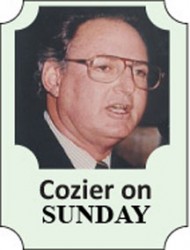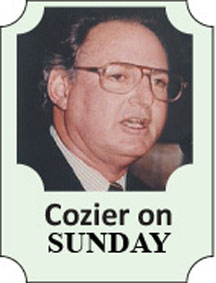THE West Indies’ back-to-back tours of India (by the ‘A’ team presently underway to be immediately followed by the seniors’ attendance at the hurriedly arranged celebration of Sachin Tendulkar’s 200th Test) offer a welcome return to the longer game for the top players and a chance for the reserves to stake their claims for promotion.
If it is all but irrelevant as preparation for players and guidance for selectors for the altogether different environment encountered in New Zealand for three Tests and five ODIs in December and January, the focus can only be on the present.
Given that, for one reason or another (player commitments to their domestic teams and to those in the Champions League), India ‘A’ are not as strong as they were on their successful preceding ‘A’ series in South Africa and at home against New Zealand, Kirk Edwards and Kraigg Brathwaite, each dropped for the  West Indies Test team more than a year ago, have wasted no time pressing for a return.
West Indies Test team more than a year ago, have wasted no time pressing for a return.
Nikita Miller, Veerasammy Permaul and Ashley Nurse have established that their spin is not only effective on sub-standard pitches back home. At last, Jonathan Carter, with bat and ball, has started to justify his repeated selections.
Miguel Cummins, at 23 a new fast bowling kid on the block with just six months first-class experience, has made an immediate impression.
Above all, the team has again demonstrated character to overcome initial defeat to take the one-day contests 2-1. Yesterday it completed a resounding victory in the first of the three ‘Tests’. It was similar in their victorious series at home against Pakistan in 2011, India in 2012 and Sri Lanka last June.
The one major disappointment is Sheldon Cottrell’s knee injury that ended his tour even before it even began. Aged 24, strong, athletic, fast and left-arm all in one, the Jamaican soldier is an exciting long-term prospect; there was no hyperbole in manager Lockhart Sebastien’s comment that it was “a devastating blow.”
If there is an apt comment on the choice of Cottrell’s replacement, it is “mystifying”. There is little logic in Fidel Edwards’ call-up.
Of those still active, he is the West Indies top wicket-taker in Tests, with 165 wickets in 55 matches; at 31 and dogged by back injuries, his prime has passed.
All his cricket this year has been of the Twenty20 variety in which he is still capable of a telling, but brief burst. Now he has been summoned for India with only two four-day matches remaining. Others with more promising futures were available (the 24-year-old Trinidadian Marlon Richards, for instance).
The teams for the two Tests and three ODIs to follow presumably won’t be named until the selectors give themselves more time to assess the ‘A’ performances. Even then, it is safe to assume that all the usual suspects will be retained.
The West Indies have had just two Tests so far in 2013, both at home against Zimbabwe, hardly a stern examination. With the ‘A’ team’s four-dayers in India the only guide to current form, the same 11 that defeated Zimbabwe at Kensington Oval and Windsor Park could well take the field against India in November.
The abbreviated versions – 20 ODIs and five Twenty20s against Australia, Zimbabwe, in the Champions Trophy, in the triangular tournament with India and Sri Lanka and against Pakistan – present a different picture.
The count in those matches was seven ODI wins (three over Zimbabwe), 12 losses, two ties. They are statistics that hint at the need for a shake-up but cautious selectors are disposed to shake-ups.
Once the Indian adventures are over, it is straight on to New Zealand from December 3 to January 15. The competition is certain to be keen between two evenly matched teams, the West Indies intent on maintaining their rise to sixth place on the ICC’s Test rankings, New Zealand eager to rise from their embarrassing position at No.9.
New Zealand have the added incentive, before their own fans, of compensating for their trouncing in the Caribbean last year (defeat in both Tests, in four of the five ODIs and in both Twenty20s).
The swift change of location takes some getting used to. Disparities between India and New Zealand, cricketing, climatic and cultural, are more pronounced than between any other Test countries. Players and selectors need to recognize them.
In India, it is hot, the pitches are dry, slow and dusty and, as it is almost certain for the revered Tendulkar’s farewell, the stands will be packed with tens of thousands of his devotees.
It is the land of spin. When the West Indies were last there in late 2011, 44 of their wickets in three Tests were gathered by the Indian spinners. England’s surprise 2-1 triumph last year was based on the 37 wickets Graeme Swann and Monty Panesar pocketed between them; India’s slow men had 43 to no avail.
In New Zealand, the West Indies will find temperatures rarely above 25 degrees Celsius; in Dunedin, Test cricket’s closest venue to the south pole, they are likely to be no more than the mid-teens.
The grounds, like the country itself, are lush green, the pitches grassy as they once were in the similar climate in England. And the sounds from the leisurely grass banks beyond the boundary will be muted hand clapping, a far cry from the cacophony in India that accompany every home appeal and boundary hit (Tendulkar’s merit near pandemonium).
When England battled to a hard-fought draw in three Tests earlier in the year, they used one spinner, Panesar. He took a solitary wicket. The fast men, Stuart Broad, James Anderson and Steven Finn, did most of the work. New Zealand’s fast-slow wicket balance was 29-15.
The statistical evidence is clear and not misleading. What works in India won’t work in New Zealand.
So, as many wickets as Miller, Permaul and Nurse snare for the ‘A’ team and Shane Shillingford and Sunil Narine in the Tests, the emphasis should be on the fast men, the pacy spearhead Kemar Roach, the towering Jason Holder, the skidding Ravi Rampaul once his fitness doesn’t let him down, perhaps Cummins.
As far-fetched as it may seem, is there a hint in his recall to India that Fidel could go back to the scene where his pacy outswing accounted for his seven wickets in New Zealand’s first innings of the second Test five years ago? Stranger choices have been made by West Indies panels before and, in New Zealand of all places, it should be horses for courses.





